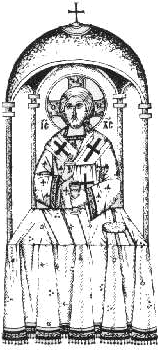General Information: Orthodox Worship
These links provide an overview of Orthodox worship. For more on the particulars of how we worship see the many articles on the "Living an Orthodox Life: Worship" page.

Worship & Sacraments, an excerpt from The Orthodox Church, by Bishop Kallistos (Ware).
"The Holies for the Holy": An Overview of the Divine Liturgy, by Fr. Michael Pomazansky. This is an excellent introduction to the main Orthodox service of worship.
Liturgy and Spirituality, by Hieromonk [now Bishop] Athanasije JEVTIĆ. Chapter 8 from Christ: The Alpha and Omega.
The Divine Services, by Archpriest Seraphim Slobodskoy. See also The Divine Liturgy.
Various Articles on the Services of the Church, from the Russian Orthodox Cathedral of St. John the Baptist.
The Great Feast Days of the Orthodox Church.
Fr. John Whiteford's Liturgical Resources Page
Introduction to the Divine Liturgy, by the Rev. George Mastrantonis. This is an account of the meaning of the original act of the Holy Eucharist, its enactment by the Church, the historical development of the Divine Liturgies as well as a diagram of the established Divine Liturgy, according to the Eastern Orthodox Church.
“Monogamous Communion”: A Defense of “Closed” Communion, by Fr. Michael Shanbour.
A Note on Churches, by Archbishop Chrysostomos of Etna. Concerning the terms used for the English word "church" and how we should view and treat the House of God.
Where Can One Go in an Orthodox Church?.
House of God, by the Rev. Thomas Fitzgerald, Holy Cross School of Theology. A brief overview of holy space.
Recommended Books
Orthodox House of Worship: Informative and Interpretive Homilies on Liturgical Themes, by Metropolitan Augustinos of Florina. This indispensable work from one of the most revered archpastors of our day contains a series of homilies on almost every aspect of Orthodox worship. Topics include not only the Divine Services but also the Church buildings, the holy items used in worship, the participants (Clergy, Altar boys, etc.). The author's very approachable and piously-written works are widely read in Greece and have been made available in recent years through the Institute for Byzantine and Modern Greek Studies—the publisher of Dr. Constantine Cavarnos' books.
The Divine Liturgies Music Project, by St. Anthony's Monastery in Florence, AZ.
On the Divine Liturgy: Orthodox Homilies, Vol. I and II, by Metropolitan Augustinos of Florina. Also from the Institute for Byzantine and Modern Greek Studies, these two books take the reader through each section of the Divine Liturgy. The instruction is in the form of homilies that not only inform but also inspire. Volume I explains the Liturgy of the Catechumens (the first half of the Divine Liturgy), and Volume II explains the Liturgy of the Faithful (the second half).
Note: On the following three commentaries, see the important article Three Byzantine Commentaries on the Divine Liturgy: A Comparative Treatment, by Bishop Auxentios of Photiki and Fr. James Thornton.
On the Divine Liturgy. One of the chief Byzantine commentaries, by St. Germanus of Constantinople.
The Church's Mystagogy, by St. Maximus the Confessor. Contained in Maximus Confessor, Selected Writings in the Classics of Western Spirituality Series.
A Commentary on the Divine Liturgy, by St. Nicholas Cabasilas. Another classic Byzantine commentary.
Festal Menaion (St. Tikhon Seminary Press): the first eighty pages and four appendices of this book offer one of the best overviews of the structure and meaning of the liturgical cycle and services found in English. Two of the appendices are especially helpful: "The Service Books of the Orthodox Church" and a "Glossary" of liturgical terms.
The Lenten Triodion (Faber & Faber): contains a wealth of information about fasting, as well as many of the liturgical texts for Great Lent. It also includes the richly eloquent and other-worldly "Canon of St. Andrew of Crete." This canon of repentance, which can be prayed throughout the year, is alone worth the price of the book.
Service Book of the Holy Orthodox-Catholic Apostolic Church (a.k.a, "Hapgood"), by Isabel Florence Hapgood (Antiochian Orthodox Christian Archdiocese): a reprint of a classic which no English-speaking Orthodox Christian can afford to be without. Contains a unique compilation of the most oft-used services, a pictorial elucidation of the symbolism found in Orthodox churches and rites, and many helpful appendices.
Church services, that is, all the daily services, together with the entire arrangement of the church's icons, candles, censing, singing, chanting, movements of the clergy, as well as the services for various needs (e.g., Molebens, Pannikhidas, etc.); then services in the home, also using ecclesiastical objects such as sanctified icons, holy oil, candles, holy water, the Cross, and incense—all of these holy things together acting upon all the senses—sight, hearing, smell, touch, and taste—are the cloths that wipe clean the senses of a deadened soul. They are the strongest and only reliable way to do it.... The entire structure of our Church services, with their tone, meaning, power of faith, and especially the grace concealed within them, have an invincible power to drive away the spirit of the world.
— St. Theophan the Recluse, The Path to Salvation, p. 254

